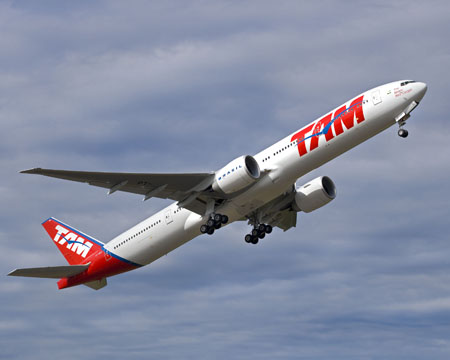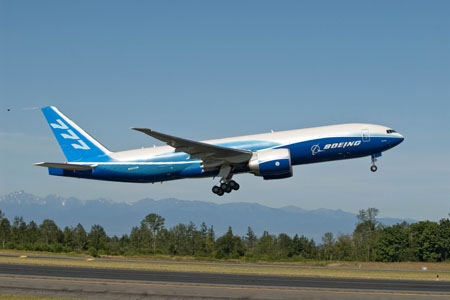FORT WORTH, Texas, March 2, 2011 — Thanks to the fuel conservation efforts of American Airlines employees, a total of $409,513 is being provided to Air Compassion for Veterans, a not-for-profit organization that helps active military, veterans and their families travel for medical, counseling and rehabilitation needs.
Through its employee-driven fuel conservation program, called Fuel Smart, American granted a portion of the proceeds from the initiative to assist those who have served or currently serve in the U.S. military when they need access to medical and related resources.
“American’s ability to make such a significant contribution to help service members and their families is a direct result of our employees’ participation in Fuel Smart,” said Matt Pfeifer, American’s Managing Director – Operations Strategic Planning. “When our troops and veterans return home, it is imperative that we all pull together to ensure that they receive access to the best possible care. This is made easier because of our employees’ tremendous fuel conservation efforts.”
In 2010, nearly 1,000 flights were made possible on American and American Eagle aircraft as a result of direct contributions from American Airlines employees. In addition to medical-related travel, Air Compassion for Veterans provides transportation for family members to visit service men and women who are undergoing treatment away from home.
“So many of our soldiers, sailors, airmen and Marines have been injured during their military service and face years of surgeries, therapy and rehabilitation,” said American Airlines First Officer Tom Marquardt, a Major in the Air Force Reserve who plays an instrumental role in American’s partnership with Air Compassion for Veterans. “The ability to go home, or to have your family visit while you’re undergoing rehab, is such an important part of the healing process. My fellow employees are helping make sure this is possible for these brave men and women.”
Today, the final 2010 donation was made during a special ceremony at American’s Maintenance & Engineering facilities at Dallas/Fort Worth International Airport. A number of employee workgroups that helped make the contribution possible were honored for their efforts.
“We are honored to partner with a company like American Airlines, which has made such a strong commitment to serving our military and veterans,” said Ed Boyer, President and CEO of Mercy Medical Airlift, the parent organization of Air Compassion for Veterans. “Without the hard work of American Airlines employees, many of the veterans and their family members simply would not be able to make important trips during rehab and recovery. On behalf of the men and women who wear the cloth of our great nation, we express our deepest thanks.”
The success of this partnership depends on employee involvement in American’s Fuel Smart program, which aims to achieve fuel savings of 138 million gallons and reduce carbon emissions by 2.9 billion pounds in 2011.
The employee-led program works across all departments to identify fuel savings opportunities and make them a part of daily routines. Several key programs drive donations and help improve fuel efficiency, including:
Pilots reducing fuel burn by using a single engine to taxi in and out of gates when possible.
Airport and flight crews working together to quickly connect ground power and pre-conditioned air hoses to planes and turning off the aircraft auxiliary power when they arrive at the terminal.
Dispatchers and flight crews using all available planning tools, procedures and expertise to safely plan flight fuel loads without carrying excess fuel.
American Airlines has a long history of supporting the nation’s armed forces and veterans, dating to World War II and C.R. Smith, the airline’s first president. Currently, more than 60 percent of American’s pilots and 10 percent of all American and American Eagle Airlines employees are active military/reservists or veterans. American supports members of the military, veterans and their families when they travel and in their communities, including special military airfares, waived baggage fees, support of non-profit organizations, and employee engagement in a wide variety of events and activities. To learn more about American’s Military/Veterans Initiatives, visit AA.com/JoinUs.
To include the featured image in your Twitter Card, please tap or click their icon a second time.

 Copa becomes first Latin America carrier to fly with the new cutting-edge interior
Copa becomes first Latin America carrier to fly with the new cutting-edge interior
 It’s being circulated on Twitter that Mesa Air is out of Chapter 11, and is now in a good position. Apparently they downsized, eliminated 200 inessential planes, and cut out unnecessary leases.
It’s being circulated on Twitter that Mesa Air is out of Chapter 11, and is now in a good position. Apparently they downsized, eliminated 200 inessential planes, and cut out unnecessary leases. 

 TAM 777-300ER fleet will now consist of 12
TAM 777-300ER fleet will now consist of 12 EVERETT, Wash., Feb. 28, 2011 /PRNewswire/ — Hauling everything from giant panda bears to high-performance race cars the Boeing 777 freighter in its first two years in service is earning the reputation as the work horse of the industry.
EVERETT, Wash., Feb. 28, 2011 /PRNewswire/ — Hauling everything from giant panda bears to high-performance race cars the Boeing 777 freighter in its first two years in service is earning the reputation as the work horse of the industry. LONDON – March 2, 2011 – Northrop Grumman Corporation’s Europe-based air traffic management subsidiary, Northrop Grumman Park Air Systems, is providing its Advanced Surface Movement Guidance and Control System ( for Greece’s Thessaloniki International Airport.
LONDON – March 2, 2011 – Northrop Grumman Corporation’s Europe-based air traffic management subsidiary, Northrop Grumman Park Air Systems, is providing its Advanced Surface Movement Guidance and Control System ( for Greece’s Thessaloniki International Airport.